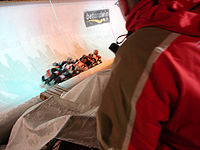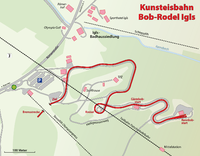- Olympic Sliding Centre Innsbruck
-
 Four-man wok racing at the 2006 World Championships held at the track. Germany's Georg Hackl is among the four-man team on the track.
Four-man wok racing at the 2006 World Championships held at the track. Germany's Georg Hackl is among the four-man team on the track.
The Olympic Sliding Centre Innsburck is a venue for bobsleigh, luge and skeleton located in Igls, Austria (southeast of Innsbruck). The most recent version of the track was completed in 1975 and is the first permanent, combination artificially refrigerated bobsleigh, luge, and skeleton track, serving as a model for other tracks of its kind worldwide.[1] It will host the bobsleigh, luge, and skeleton competitions for the 2012 Winter Youth Olympics.[2]
Contents
History
In 1935, Igls hosted the two-man event of the world bobsleigh championships when the track ran from Römerstrasses to the Patscherkofel valley railroad station.[1][3] Several fatal accidents at the finishing curve occurred during competition, causing temporarily closure of the track until safety measures were introduced.[1] In 1960, Innsbruck was awarded the 1964 Winter Olympics which led to the construction of separate bobsleigh and luge tracks for the games.[4] Track construction began in September 1961 and was officially completed in July 1963 following test runs of both tracks, including twenty injuries during the 1963 FIBT World Championships on the bobsleigh track.[4][5] Prior to the start of the 1964 Winter Olympics, British luger Kazimierz Kay-Skrzypeski was killed in a training run on the luge course.[6] When Denver, Colorado, in the United States withdrew in 1972 after being awarded the 1976 Winter Olympics two years earlier for financial reasons, the International Olympic Committee offered the games to 1976 runner-up Whistler, British Columbia in Canada (northeast of Vancouver), but Whistler declined in the wake of the provincial elections in 1972. As a result, the IOC gave the games to Innsbruck. Construction on a new, combined track was started in 1973 under the auspices of the International Bobsleigh and Tobogganing Federation (FIBT) and the International Luge Federation (FIL) and completed the following year.[1][7] The track was praised by the FIL during testing in 1975 [8] and proved so successful that it fostered a commission with the FIBT and the FIL on construction of combination tracks in 1977 that continues to this day.[9] (Known as homologation, an example of this dual certification process occurred prior to the 2006 Winter Olympics, when adjustments to the track at Cesana Pariol were made following FIL concerns about the run.[10][11]) The track added a restaurant and was extended in 1981.[1] In 1990-1, the ladies start house at the fifth turn was renovated and the finishing stretch was extended in 1998.[1] The track was part of the OlympiaWorld-Innsbruck in 2004, the same year a general refurbishment was done on the concrete shell.[1] Today, it serves as a training facility for new bobsledders and skeleton racers.[12] It will host the bobsleigh, luge, and skeleton events for the 2012 Winter Youth Olympics.[2]
Statistics
Modern track Sport[1][7] Length of track (meters) Number of turns Grade Bobsleigh, skeleton, and Luge - men's singles 1270 14 14 Luge - women's singles & men's doubles[7][13] 870 10 8.5% The track has a vertical drop of 98.1 meters.[12]
The 1964 Winter Olympic bobsleigh track, designed by former bobsledder and luger Paul Aste, consisted of 14 turns with a total length of 1506.36 meters, a vertical drop of 138 meters, and a maximum grade of 14.04%.[4]
1964 bobsleigh track turns[4][5] Turn Number Name (German) Translated name 1. Startkurve "Start curve" 2., 3. Hohes S "High S" curves 4. Stützenkurve "Support curve" 5. Höcker "Peak" curve 6. Fuchsloch "Fox hole" 7. Hohle Gasses "Hollow lane" 8. Schanze "Dig" 9. Hexenkessel "Witch's pot" 10. - 11. Nadelöhr "Needle-eye" S curves 12. Burlepautz 13. Weckauf "Wake on" 14. Zielkurve "Finish curve" The 1964 Winter Olympic luge track, designed by former bobsledder and luger Paul Aste, consisted of 18 turns with a total length of 1063.76 meters for men singles and a vertical drop of 113.20 meters, and a maximum grade of 18.18%.[4] For women's singles and men's doubles, the length was 910.00 meters with a vertical drop of 86.27 meters[4]
1964 luge track turns[4] Turn Number Name (German) Translated name 1. Startkurve 2., 3. Labyrinth Two turns in quick succession without a straight (labyrinth) 4. Waldkurve "Wood curve" 5. Stoßwand "Impact wall" 6. Gletscherblick "Glacier view" 7. Hängematte "Hammock" 8. Wasserschlupf "Water slip" 9. Promenade "Promenade" 10. Fuchsloch 11. Koflkehre - 12. Schoß "Shot" 13. - 14. Mausfalle "Mouse case" 15. Olympiakurve "Olympic curve" 16. Wassertrog "Water trough" 17. Zielgerade "Finish line curve" 18. Zielkurve 1976 combination track Turn Number Name Reason named 4., 5., 6. Upper labyrinth Three turns in quick succession without a straight (labyrinth) 7. Kreisel 270-degree Kriesel (circular) curve 11., 12., 13. Lower labyrinth Three turns in quick succession without a straight (labyrinth) Turns 1-3, 8-10, 14, and 15 have no names listed in the track diagram.[7]
Track records Sport Record Nation - athlete(s) Date Time (seconds) Bobsleigh two-woman[14] Start  Canada - Kaillie Humphries & Heather Moyse
Canada - Kaillie Humphries & Heather Moyse22 January 2010 5.50 Bobsleigh two-woman[14] Track  United States - Shauna Rohbock & Michelle Rzepka
United States - Shauna Rohbock & Michelle Rzepka22 January 2010 53.47 Luge - men's singles[15] Start Johannes Ludwig -  Germany
Germany29 November 2009 3.865 Luge - men's singles[15] Track David Möller -  Germany
Germany29 November 2008 48.533 Luge - women's singles[15] Start Tatjana Hüfner -  Germany
Germany28 November 2009 2.003 Luge - women's singles[15] Track Natalie Geisenberger -  Germany
Germany28 November 2009 39.569 Luge - men's doubles[15] Start  Austria - Markus Schiegl & Tobias Schiegl
Austria - Markus Schiegl & Tobias Schiegl29 November 2008 1.927 Luge - men's doubles[15] Track  Germany - Patric Leitner & Alexander Resch
Germany - Patric Leitner & Alexander Resch28 November 2009 39.278 Skeleton - men[16] Track Alexander Tretiakov -  Russia
Russia13 December 2008 52.93 Skeleton - woman[17] Start Courtney Yamada -  United States
United States
Amy Williams - United Kingdom
United Kingdom12 December 2008 5.33 Skeleton - women[17] Track Shelley Rudman -  United Kingdom
United Kingdom12 December 2008 54.65 Championships hosted
- 1964 Winter Olympics
- 1976 Winter Olympics
- 2012 Winter Youth Olympics
- FIBT World Championships: 1935 (two-man), 1963,[3] 1991 (men's skeleton), 1993 (bobsleigh), 2000 (skeleton)[18]
- FIL European Luge Championships: 1990[19]
- FIL World Luge Championships:[20] 1977, 1987, 1997, 2007
See also
- Rodelbahn
References
- ^ a b c d e f g h History of the Igls bobsleigh, luge, and skeleton track
- ^ a b 2012 Winter Youth Games venue listings in bid packages. - accessed 2 June 2010.
- ^ a b Bobsleigh two-man world championship medalists since 1931
- ^ a b c d e f g 1964 Winter Olympic Games Official report. pp. 40, 65, 69, 165, 178, 180. (German)
- ^ a b Time magazine February 15, 1963 article on the 1964 bobsleigh track competition that lead to safety changes on the track
- ^ Wallechinsky, David and Jaime Loucky (2009). "Luge (Tobaggan): Men". In The Complete Book of the Winter Olympics: 2010 Edition. London: Aurum Press Limited. p. 168.
- ^ a b c d 1976 Winter Olympics official report, pp. 143-5, 153, 186-7, 206-208. (English), (French), and (German)
- ^ "Luge and Olympism." December 1983. p. 854.
- ^ "Bobsleigh and Olympism." Olympic Review. December 1984. p. 1012.
- ^ FIBT President Storey and FIL President Fendt: "Olympic Track Summitt" in Berchtesgaden at the Fédération Internationale de Luge de Course (6 June 2005 article accessed 2 December 2009.)
- ^ 2006 Olympic Track in Cesana Pariol homologated by FIL. at the Fédération Internationale de Luge de Course (31 October 2005 article accessed 2 December 2009.)
- ^ a b FIBT track profile
- ^ List of artificial tracks used - Click on Igls link for popup
- ^ a b Rohbock Wins Women's Bob Finale; Martini Takes European Crowd. at the Fédération Internationale de Bobsleigh et de Tobogganing (22 January 2010 article accessed 22 January 2010.)
- ^ a b c d e f From results shown from the FIL World Cup event during 28–29 November 2009 from live track results.
- ^ Rommel Overtakes Tretiakov in Igls Skeleton at the Fédération Internationale de Bobsleigh et de Tobogganing
- ^ a b Rudman Wins Women's Skeleton World Cup in Igls at the Fédération Internationale de Bobsleigh et de Tobogganing
- ^ FIBT men's skeleton world championships results since 1989
- ^ FIL European Luge Championships mens's singles results since 1914
- ^ FIL World Luge Championships men's single results since 1955
External links
- FIBT track profile - Click on video link for track. Luge - men's singles intersects with the bobsleigh & skeleton part of the track prior to turn one, then where luge - women's singles & men's doubles intersect with bobsleigh-skeleton prior to turn five.
- FIL-Luge.org track profile
- Official website (English) & (German)
Bobsleigh, luge, and skeleton tracks Current artificial tracks Altenberg · Calgary · Cesana · Cortina d'Ampezzo · Igls · Königssee · Lake Placid · La Plagne · Lillehammer · Nagano · Oberhof · Paramonovo · Park City · Sigulda · St. Moritz · Whistler · WinterbergFormer artificial tracks Alpe d'Huez · Chamonix · Garmisch-Partenkirchen · Hammarstrand · Imst · Oslo · Teineyama bobsleigh · Teineyama luge · Trebević · Villard-de-LansFuture artificial tracks Natural luge tracks Venues of the 1964 Winter Olympics Axamer Lizum • Bergiselschanze • Bob und Rodelbahn Igls • Eisschnellaufbahn • Messehalle • Olympiahalle • Patscherkofel • SeefeldVenues of the 1976 Winter Olympics Axamer Lizum • Bergiselschanze • Eisschnellaufbahn • Kominierte Kunsteisbahn für Bob-Rodel Igls • Messehalle • Olympiahalle • Patscherkofel • Seefeld1924: La Piste de Bobsleigh des Pellerins • 1928: St. Moritz-Celerina Olympic Bobrun • 1932: Mt. Van Hoevenberg Bob-Run • 1936: Riessersee • 1948: St. Moritz-Celerina Olympic Bobrun • 1952: Korketrekkeren • 1956: La piste bob • 1964: Bob und Rodelbahn Igls • 1968: Piste de Bobsleigh • 1972: Mt. Teine Bobsleigh Course • 1976: Kominierte Kunsteisbahn für Bob-Rodel Igls • 1980: Mt. Van Hoevenberg Bob and Luge Run • 1984: Trebević • 1988: Canada Olympic Park (includes bobsleigh/luge track) • 1992: La Plagne • 1994: Lillehammer Olympic Bobsleigh and Luge Track • 1998: Spiral • 2002: Utah Olympic Park (bobsleigh, luge, and skeleton track) • 2006: Cesana Pariol • 2010: The Whistler Sliding Centre • 2014: Russian National Sliding Centre • 2018: Alpensia Sliding Centre 1964: Bob und Rodelbahn Igls • 1968: Piste de Luge • 1972: Mt. Teine Luge Course • 1976: Kominierte Kunsteisbahn für Bob-Rodel Igls • 1980: Mt. Van Hoevenberg Bob and Luge Run • 1984: Trebević • 1988: Canada Olympic Park (includes bobsleigh/luge track) • 1992: La Plagne • 1994: Lillehammer Olympic Bobsleigh and Luge Track • 1998: Spiral • 2002: Utah Olympic Park (includes bobsleigh, luge, and skeleton track) • 2006: Cesana Pariol • 2010: The Whistler Sliding Centre • 2014: Russian National Sliding Centre • 2018: Alpensia Sliding Centre
1964: Bob und Rodelbahn Igls • 1968: Piste de Luge • 1972: Mt. Teine Luge Course • 1976: Kominierte Kunsteisbahn für Bob-Rodel Igls • 1980: Mt. Van Hoevenberg Bob and Luge Run • 1984: Trebević • 1988: Canada Olympic Park (includes bobsleigh/luge track) • 1992: La Plagne • 1994: Lillehammer Olympic Bobsleigh and Luge Track • 1998: Spiral • 2002: Utah Olympic Park (includes bobsleigh, luge, and skeleton track) • 2006: Cesana Pariol • 2010: The Whistler Sliding Centre • 2014: Russian National Sliding Centre • 2018: Alpensia Sliding Centre
Coordinates: 47°13′20″N 11°25′48″E / 47.22216°N 11.43004°E
Categories:- 1964 Winter Olympics venues
- 1976 Winter Olympics venues
- Bobsleigh, luge, and skeleton tracks
- Olympic bobsleigh venues
- Olympic luge venues
- Sports venues in Austria
- Venues of the 2012 Winter Youth Olympics
Wikimedia Foundation. 2010.

